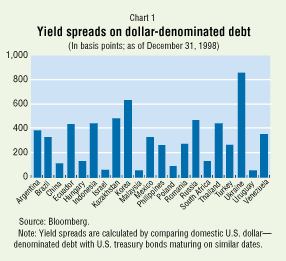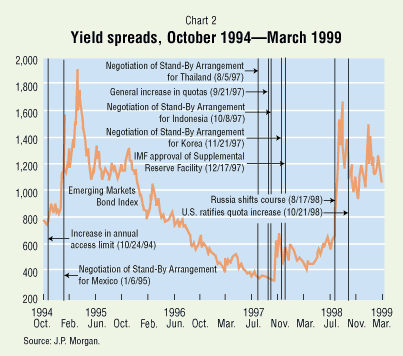 About F&D Subscribe Back Issues Write Us Copyright Information |
IMF Financing and Moral Hazard Timothy Lane and Steven Phillips Although it has been argued that IMF financing may create moral hazard, it is not easy to find clear evidence of such an effect. If the extent of IMF-induced moral hazard were known, any costs would have to be weighed against the possible benefits of IMF financing. "Moral hazard" is a term frequently heard in recent debates over the reform of international financial institutions. In other words, critics argue that the knowledge that IMF financing will be made available in the event of a financial crisis makes the crisis more likely to occur. The idea is that creditors know that IMF financing helps crisis-prone countries stave off default and are therefore willing to lend to such countries at lower interest rate spreads than would prevail if the IMF did not exist. The IMF's presence thus weakens pressure on governments to pursue policies—such as sustainable fiscal policies and sound financial supervision and regulation—that could help prevent crises. Associated with this view is the suggestion that moral hazard may have increased in recent years. It has been argued, in particular, that the IMF's response to Mexico's crisis in early 1995 signaled a new era of massive "bailouts" that inspired higher levels of risk taking and set the stage for crises in East Asia, Russia, and Brazil just a few years later. Implications of IMF financing The argument that IMF financing creates moral hazard cannot be lightly dismissed. If one believes that IMF financing helps some countries pull back from the brink of default and otherwise mitigates the costs of a crisis for the country affected, and if one believes that market participants and governments respond to incentives, some degree of moral hazard is an unavoidable consequence. Moral hazard is also an unavoidable consequence of any insurance. For example, insuring motorists clearly contributes to the frequency of accidents: if such insurance were banned, drivers would surely be somewhat more careful because they would be aware that a moment of carelessness could cost them everything they own. However, few people would advocate prohibiting automobile insurance; its benefits in cushioning individuals against the risk of unforeseeable events clearly outweigh any adverse impact on driving safety. This analogy suggests that, in order to make the case for abolishing or drastically overhauling the IMF, one must show not only that IMF financing is likely to significantly affect the incentives facing countries and their creditors but also that the moral hazard generated by the availability of IMF financing overshadows any potentially beneficial effects in mitigating crises. One benefit is that, in a liquidity crisis, IMF financing may help compensate for a market failure—the collective-action problem associated with creditors' self-defeating race to the exits. If the IMF can help resolve such a situation by providing liquidity, both the country and its creditors—and perhaps other countries that would have been affected by contagion—benefit. Moreover, this benefit would come at no loss to the IMF, provided that the IMF were repaid with interest. If resolving this collective-action problem makes countries and their creditors more confident in undertaking international transactions, this kind of moral hazard represents a net gain in international financial stability. Evidence of moral hazard Before basing any policy decisions on the moral hazard problem, one should examine some evidence on how significant the problem is likely to be in practice. Despite many assertions in policy discussions that moral hazard is a major cause of financial crises, there has been astonishingly little effort to provide empirical support for this belief. One key piece of empirical evidence is the interest rate spreads paid on emerging market bonds. Do these spreads behave in a way that indicates that investors see the IMF as ready to cushion the blow if a country runs into serious difficulties? If they do, this fact alone would not establish that IMF financing makes crises much more likely to happen—because how governments respond to the behavior of spreads must also be considered—but it would be a first step. We can make a painfully simple observation, albeit one that should not be overlooked. The mere existence of such spreads makes it possible to reject an extreme form of the moral hazard hypothesis: that investors are sure they will be bailed out in the event of a crisis. If this were true, every IMF member country should be able to borrow at the same, risk-free rate. In fact, spreads are often wide and differ considerably across countries—with large spreads even for some countries that one might expect to be "too big to fail" (see Chart 1).
 The "news" approach Another way to look for evidence of moral hazard in emerging market interest rate spreads is through an approach (an event study, or "news," approach) that focuses on information that may have led to changes in moral hazard. One can examine how these spreads reacted at the time of various policy announcements that might have conveyed new information to markets about the future availability or scale of IMF financial support to member countries. If IMF financing creates moral hazard to an important degree, spreads should respond immediately to such announcements. By using daily data and examining the behavior of spreads over very short periods, this approach seeks to isolate the influence of the IMF-related news from other factors. We studied the period from early 1995 to 1999, which turns out to be rich in events that could have influenced moral hazard. These include the large assistance packages provided to Mexico and other countries, the decision to substantially increase the financial resources of the IMF, and the ratification of the increase by the U.S. Congress in October 1998. In the other direction, the IMF's August 1998 decision to stand back while Russia defaulted on its domestic debt could be viewed as news that reduced moral hazard. The data show that emerging market interest rate spreads did not change very much around the time of most of the 22 events examined (Chart 2). In most cases, the movements at the time of the announcements were within the usual range of daily fluctuations and often went in the opposite direction from what would be expected if moral hazard were at play. For example, the 1995 Mexican bailout caused hardly a ripple in other emerging markets, suggesting that investors in Korea and Thailand did not consider the Mexican events to have much relevance for them.
 There are, however, a couple of cases in which the evidence, while ambiguous, is consistent with moral hazard:
These are the only 2 out of 22 episodes examined that show behavior of interest rate spreads consistent with moral hazard. Even for these events, the behavior of interest rates is difficult to separate from other contemporaneous events and from turbulent market conditions more generally. So why does one not find more pervasive evidence of moral hazard? One explanation is that, although theoretically plausible, moral hazard created by the IMF is actually not very significant compared with the numerous other factors affecting asset prices and interest rate spreads on a day-to-day basis. This could be because the scale of IMF financing is simply not large enough to guarantee all creditor positions; this explanation is consistent with data on the size of IMF support in relation to several possible indicators. An alternative explanation is that the "event study" approach may not have the power to detect changes in the degree of moral hazard—for instance, if the events examined were not viewed as signaling any change in the availability of IMF financing, if the events were expected and thus already factored into market prices, or if it took a long time for markets to digest the implications of the events. Finally, the perception of a greater availability of IMF financing may have made emerging market countries more willing to borrow, and, if so, the resulting effects on interest rate spreads could have offset those of creditors' greater willingness to lend; this possibility may need to be explored through an examination of the quantities of financing provided to emerging markets as well as the interest rate spreads. The present study, it must be stressed, is not intended to be the last word on this question; if it engenders further research in place of the unfounded assertions sometimes made in public debate, it will have served its purpose. Policy implications In conclusion, while some element of moral hazard is a logical consequence of the availability of IMF financing, any policy implications must hinge on an assessment of the empirical significance of moral hazard. This article takes a modest step in this direction by examining the behavior of interest rate spreads. While the failure to identify clear evidence of moral hazard may reflect shortcomings in the tests used, it also highlights the weakness of the empirical foundations of many of the assertions made in policy debates. These results do not, of course, obviate the need to consider the implications of moral hazard in assessing possible reforms to the international financial system. Even if moral hazard is not yet empirically important, it could become so if these arrangements or market mechanisms were to change. Moreover, the results do not minimize the need for sensible steps to prevent IMF financing from serving primarily to bail out private creditors, such as the recent efforts to secure greater private sector involvement in addressing financial crises. But such policies should not be guided by an unsubstantiated belief that moral hazard is an overwhelming problem. As long as further evidence is needed to establish the magnitude of moral hazard, such action should proceed cautiously, weighing the possibility of moral hazard against other implications of the availability of IMF financing in alleviating the effects of crises.
This article is based on the authors' "Does IMF Financing Result in Moral Hazard?" IMF Working Paper 00/168 (Washington: International Monetary Fund, 2000).
|